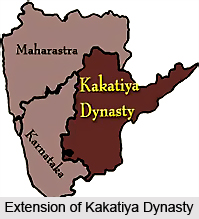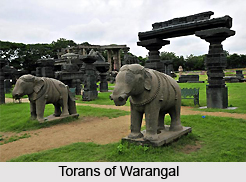 If one speaks regarding great dynasties of Andhra Pradesh then, The Kakatiyas who reigned between the 1 lth and 14th centuries A.D. would be the first to be spoken about. They belonged to the Durjaya family and believed that a distant ancestor had settled in Kakatipura, a place which historians are unable to identify.
If one speaks regarding great dynasties of Andhra Pradesh then, The Kakatiyas who reigned between the 1 lth and 14th centuries A.D. would be the first to be spoken about. They belonged to the Durjaya family and believed that a distant ancestor had settled in Kakatipura, a place which historians are unable to identify.
All information about this dynasty can be obtained frim their inscriptions. In some of their inscriptions they are called `lords of Kakatipura` and also as rulers of the Andhra or Telunga area.The earliest known king of this dynasty was Beta I, who was later defeated by the Chola army, probably during the reign of Rajendra Chola I (1012-1044 A.D.), which marched through the ancient Andhra country on its way to the river Ganga. A vassal of Beta I named Era defeated the Chola viceroy at this place and reestablished his ruler on the throne.
Beta was succeeded by his son Prola I and subsequently by Prola`s son Beta II. Both Prola and Beta accepted the Western Chalukya kings as their overlords. Beta II made Anmakonda his capital. His son Prota II took advantage of the weakness that had set in the Chalukyan Empire after the death of Vikra-maditya VI in 1126 A.D. and his aggressive military tactics led to the Kakatiyas ruling as independent chiefs from this time.
His successor Rudra I consolidated the conquests of his father. He was also a scholar who authored the Nitisarain Sanskrit. Temples belonging to his reign are found at Anmakonda, Pillimari and Mantrakuta. Rudra also constructed a shrine for Lord Siva in the city of Orungallu or Ekasilanagari (modern Warangal) which was at that time gradually becoming a very important city. Around 1195 A.D., he was succeeded by his brother Mahadeva, who was of a religious bent of mind and neglected the affairs of the Kakatiya kingdom. Yadava Jaitugi, the ruler of Devagiri, invaded the Kakatiya territory, killed Mahadeva and took his young son Ganapati captive.
 Later, Jaitugi, out of compassion, crowned Ganapati as the king of the Kakatiyas in 1198 A.D. Ganapati proved to be a much stronger ruler than his father and conquered all the areas in south Andhra Pradesh upto Kanchipuram (Tamil Nadu) and also defeated the Hoysala kings. His vast kingdom extended from Godavari district in the north up to Kanchipuram in the south and from Yelgandal in erstwhile Hyderabad state up to the sea. However, the illustrious Pandyan monarch, Jatavarman Sundara Pandya I invaded Kanchi around 1250 A.D. and defeated the Kakatiya army.
Later, Jaitugi, out of compassion, crowned Ganapati as the king of the Kakatiyas in 1198 A.D. Ganapati proved to be a much stronger ruler than his father and conquered all the areas in south Andhra Pradesh upto Kanchipuram (Tamil Nadu) and also defeated the Hoysala kings. His vast kingdom extended from Godavari district in the north up to Kanchipuram in the south and from Yelgandal in erstwhile Hyderabad state up to the sea. However, the illustrious Pandyan monarch, Jatavarman Sundara Pandya I invaded Kanchi around 1250 A.D. and defeated the Kakatiya army.
Ganapati shifted his capital city to Orgungallu (Warangal) from Anmakonda and it flourished as the very famous capital city of the Kakatiyas till this dynasty finally came to an end. A very well-known sea-port of this kingdom was Motupalli (Krishna district) where trade flourished due to the farsightedness of this monarch who abolished repressive taxes which foreigners had earlier been made to pay. Since Ganapati had no sons, he was succeeded by one of his daughters named Rudramba, a lady of great capacity who has been praised in the writings of Marco Polo, the Venetian traveler who visited Motupalli in 1293 A.D. Her daughter Mummadamba`s son Prataparudra was actively involved with governance from 1290 A.D. and was nominated by Rudramba as the successor to the Kakatiya throne.
Prataparudra is probably the best known monarch of the Kakatiya dynasty. He began an aggressive military campaign to recapture all the territories lost by his ancestors. Unfortunately, his efforts were interrupted by the invasion of the army of Allauddin Khilji, the Sultan of Delhi. He fought valiantly against this army led by a general named Malik Kafur in 1309-1310 A.D., but had to surrender all his treasures to the invaders in order to buy peace. When the Muslim army retreated, Prataparudra renewed his campaign, captured Nellore, Kanchipuram, and all the areas up to Tiru-chirapalli in the Tamil country. The Kakatiya kingdom was thus transformed into an empire spreading from the river Godavari to Tiru-chirapalli in die Tamil country and from Medak to the sea. Most unfortunately, this illustrious ruler did not enjoy die fruits of his hard work. The army of Ghias-ud-din Tughlug, led by his son, invaded Warangal in 1322 A.D. and Prataparudra was taken prisoner. The whole of the Telengana area was absorbed into the Tughlaq Empire. Prataparudra, it is believed, died enroute to Delhi and nothing concrete about the Kakatiyas is known after this date.



















